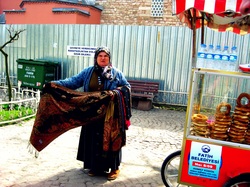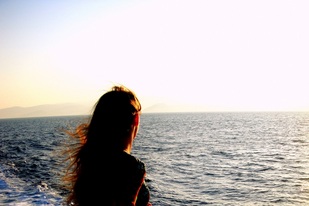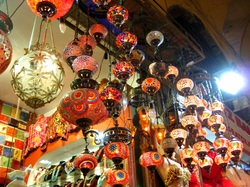Ruminations on Patmos - march 26, 2011
Today we woke up early to bread and honey sandwiches made for us by the family that runs our hotel. After sunrise, we hopped onto a boat and began our four-hour journey to the small Greek island of Patmos, or, as our tour guide likes to put it, “The Jerusalem of the Aegean Sea.” John wrote the book of Revelation on this island, and it’s undeveloped enough that I can almost picture how it would’ve looked when he was here 2,000 years ago. There is a blue, crescent-shaped harbor set off by bright white houses and lush greenery. Then there’s the sky! It’s been offsetting the deep blue waves all day. Out on the boat, if we stepped out onto the deck we could watch petrels and gulls swooping and gliding in the sun. In short, it’s been a breathtaking day.
Upon arriving at Patmos, we met out Greek guide Margarita and she took us to the cave where John is said to have received his visions. The cave has now been closed in by walls and has one small window overlooking the sea in order to create an Orthodox church. I spent most of my time inside observing a highly frazzled priest. He was looking for something and desperately opening and slamming books closed, yelling, and shoving people. The cave was also decorated with icons, gold, and flowers that were around the fenced-in area where John is said to have “laid his head”, and a silver flowery frame around where he “placed his hand in order to stand.” I couldn’t help thinking that I would like it much better if it was still just a cave without walls blocking the view of the sea.
After that we went to visit a monastery and then were given free time to explore the town or beach. We Link girls started with the town! After attempting to convince a Greek woman to let us use our Turkish lira to buy ice cream (and failing) we headed for the beach. On our way to the beach, a dog that has been described by some people as a “balloon animal seconds before popping,” and by others as “a massive sausage supported by toothpicks,” began to follow us. We disputed over his name, some of us wanted to name him “Patmos” while others, and I’m not saying who, were rooting more for “Fatmos.” Cough-cough-Elliot-cough. We set up on the beach, rolled our pants up to step in, and played with Patmos in the sand.
That was when I noticed a blue-green piece of seaglass in the sand. I’ve grown up collecting seaglass to put in jars back home, so finding it in Greece felt really special to me and I immediately jumped up and began combing the beach for more. The concept behind seaglass is meaningful for me. It starts out as a sharp glass bottle that finds itself somehow launched into a place as foreign and vast as the sea. It’s tumbled about in the sea, through rough and smooth waters, until it eventually comes across a beach.But its journey is only just beginning. By now it has shattered into tiny pieces but it’s still jagged around the edges. And so, the little bits of glass are battered against the rock and sand, over and over again. They do not realize this is necessary for them to become smooth. The amount of time each fragment of glass is whipped into the shore changes, some just take longer to lose their roughness, but in the end the result is the same: little bright colorful things that catch my eye as I walk along the water. Seaglass always reminds me that the journey I’m on might seem difficult and tumultuous, but at least I’m always heading towards a better place. It’s like when Rumi said, “birds do not learn to fly until they lose all their feathers,” likewise seaglass cannot become smooth and peaceful until it’s been tossed and battered repeatedly. People are the same. We need to be tested, softened and renewed. Remembering all the while that our journey is not over.
So, as I collected the small seaglass off the beach of an island in Greece, I could not help but be insanely grateful. This trip has been a wildly awesome opportunity, but also full of calm reminders of the things I feel are beautiful in the world…
Upon arriving at Patmos, we met out Greek guide Margarita and she took us to the cave where John is said to have received his visions. The cave has now been closed in by walls and has one small window overlooking the sea in order to create an Orthodox church. I spent most of my time inside observing a highly frazzled priest. He was looking for something and desperately opening and slamming books closed, yelling, and shoving people. The cave was also decorated with icons, gold, and flowers that were around the fenced-in area where John is said to have “laid his head”, and a silver flowery frame around where he “placed his hand in order to stand.” I couldn’t help thinking that I would like it much better if it was still just a cave without walls blocking the view of the sea.
After that we went to visit a monastery and then were given free time to explore the town or beach. We Link girls started with the town! After attempting to convince a Greek woman to let us use our Turkish lira to buy ice cream (and failing) we headed for the beach. On our way to the beach, a dog that has been described by some people as a “balloon animal seconds before popping,” and by others as “a massive sausage supported by toothpicks,” began to follow us. We disputed over his name, some of us wanted to name him “Patmos” while others, and I’m not saying who, were rooting more for “Fatmos.” Cough-cough-Elliot-cough. We set up on the beach, rolled our pants up to step in, and played with Patmos in the sand.
That was when I noticed a blue-green piece of seaglass in the sand. I’ve grown up collecting seaglass to put in jars back home, so finding it in Greece felt really special to me and I immediately jumped up and began combing the beach for more. The concept behind seaglass is meaningful for me. It starts out as a sharp glass bottle that finds itself somehow launched into a place as foreign and vast as the sea. It’s tumbled about in the sea, through rough and smooth waters, until it eventually comes across a beach.But its journey is only just beginning. By now it has shattered into tiny pieces but it’s still jagged around the edges. And so, the little bits of glass are battered against the rock and sand, over and over again. They do not realize this is necessary for them to become smooth. The amount of time each fragment of glass is whipped into the shore changes, some just take longer to lose their roughness, but in the end the result is the same: little bright colorful things that catch my eye as I walk along the water. Seaglass always reminds me that the journey I’m on might seem difficult and tumultuous, but at least I’m always heading towards a better place. It’s like when Rumi said, “birds do not learn to fly until they lose all their feathers,” likewise seaglass cannot become smooth and peaceful until it’s been tossed and battered repeatedly. People are the same. We need to be tested, softened and renewed. Remembering all the while that our journey is not over.
So, as I collected the small seaglass off the beach of an island in Greece, I could not help but be insanely grateful. This trip has been a wildly awesome opportunity, but also full of calm reminders of the things I feel are beautiful in the world…
Türkiye’yi seviyorum! - march 19, 2011

Yesterday, we sat on a boat touring the Bosphorus together. The moment we passed a big seaside mosque, the third prayer of the day (there are five: one at sunrise, one at noon, one in the afternoon, one at sunset, and one at night) came bellowing out of its minarets and dancing across the water. I took a moment to soak in the beauty of it. The prayer was more like a song, not at all monotone or emotionless. I couldn’t understand a single word of it, but the deep rhythm stirred something in me. This was the most special part of our Turkey trip so far for me. Jelalludin Rumi, the Sufi Leader from Turkey, said, “Give up subtle thinking, the twofold, threefold, multiplication of mistakes. Listen to the sound of waves within you.” In that moment, I was reminded of this quote, and a sense of peace unfolded inside me.
Turkey also has a wild and chaotic side. I’ve seen it in the busyness and colors alive in the Grand Bazaar, where everywhere I looked were salesmen with “genuine fake” goods, as our guide Çenk worded it, and a multitude of sounds. I saw the same wildness again in the Spice Bazaar on Tuesday, where I tried Turkish delight in every color possible. Literally every other store had a different sample tray to offer us! I zigzagged across the market at least three dozen times, just tasting. On Monday, Cezanna, Elliot, and I found a street seller with bizarre-looking foreign desserts. I asked him what one was and he simply said, “sweet.” I guess that was all we needed to know because we bought it and it was without question the most delicious dessert I’ve had in my life. I still haven’t been able to figure out what it’s called here, but it had a sort of honey-soaked top and bottom layers with a cream cheese-like layer in the middle. There were shops selling teas and spices with the most exotic names and wonderful scents. I plan on buying some hibiscus flower tea when we return to Istanbul! Every direction I look there are the brightest scarves and Turkish “evil eyes,” and I am enchanted.
At first, when we girls put on our head scarves in the Sultanahmet (Blue) Mosque, it felt like playing dress up, but over the past three days I’ve grown more and more curious about the lives of women here. The salesmen certainly aren’t afraid to use cheesy and faltering English to get our attention, but I’ve only spoken with one Turkish woman so far. I desperately wish I spoke the language so I could really get to know the people here better; that’s the most frustrating difference between here and Spain, because in Spain I could fairly freely express myself in the native language, but here I cannot.
It’s mesmerizing to see so many places from so long ago. It’s not something I’m accustomed to from living in the United States, where one hundred years seems like forever. Museums here have gone back and forth between mosques and churches for thousands of years. Turkey alone has been a part of three different empires! When I look up at the Hagia Sophia and other buildings around here, it’s mind-boggling. How did they build those? Russel said in our gratitude meeting on Monday night that he sees these buildings as monuments to God, and reflected in the people who spent their lives constructing great mosques like those. He spoke about how he wants to figure out how to make his life more of a monument to God, and I thought that was a beautiful way of looking at it. It’s bittersweet to see half of a gold mosaic torn back to only plaster, a crazy glimpse of what once was. Türkiye’yi seviyorum! (I love Turkey!)
Turkey also has a wild and chaotic side. I’ve seen it in the busyness and colors alive in the Grand Bazaar, where everywhere I looked were salesmen with “genuine fake” goods, as our guide Çenk worded it, and a multitude of sounds. I saw the same wildness again in the Spice Bazaar on Tuesday, where I tried Turkish delight in every color possible. Literally every other store had a different sample tray to offer us! I zigzagged across the market at least three dozen times, just tasting. On Monday, Cezanna, Elliot, and I found a street seller with bizarre-looking foreign desserts. I asked him what one was and he simply said, “sweet.” I guess that was all we needed to know because we bought it and it was without question the most delicious dessert I’ve had in my life. I still haven’t been able to figure out what it’s called here, but it had a sort of honey-soaked top and bottom layers with a cream cheese-like layer in the middle. There were shops selling teas and spices with the most exotic names and wonderful scents. I plan on buying some hibiscus flower tea when we return to Istanbul! Every direction I look there are the brightest scarves and Turkish “evil eyes,” and I am enchanted.
At first, when we girls put on our head scarves in the Sultanahmet (Blue) Mosque, it felt like playing dress up, but over the past three days I’ve grown more and more curious about the lives of women here. The salesmen certainly aren’t afraid to use cheesy and faltering English to get our attention, but I’ve only spoken with one Turkish woman so far. I desperately wish I spoke the language so I could really get to know the people here better; that’s the most frustrating difference between here and Spain, because in Spain I could fairly freely express myself in the native language, but here I cannot.
It’s mesmerizing to see so many places from so long ago. It’s not something I’m accustomed to from living in the United States, where one hundred years seems like forever. Museums here have gone back and forth between mosques and churches for thousands of years. Turkey alone has been a part of three different empires! When I look up at the Hagia Sophia and other buildings around here, it’s mind-boggling. How did they build those? Russel said in our gratitude meeting on Monday night that he sees these buildings as monuments to God, and reflected in the people who spent their lives constructing great mosques like those. He spoke about how he wants to figure out how to make his life more of a monument to God, and I thought that was a beautiful way of looking at it. It’s bittersweet to see half of a gold mosaic torn back to only plaster, a crazy glimpse of what once was. Türkiye’yi seviyorum! (I love Turkey!)


